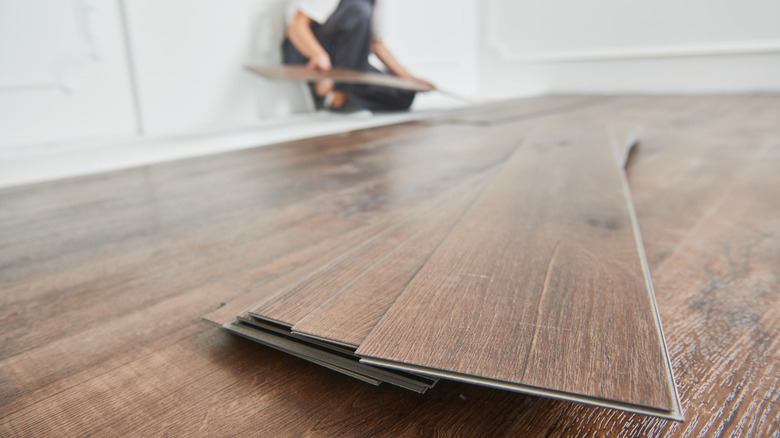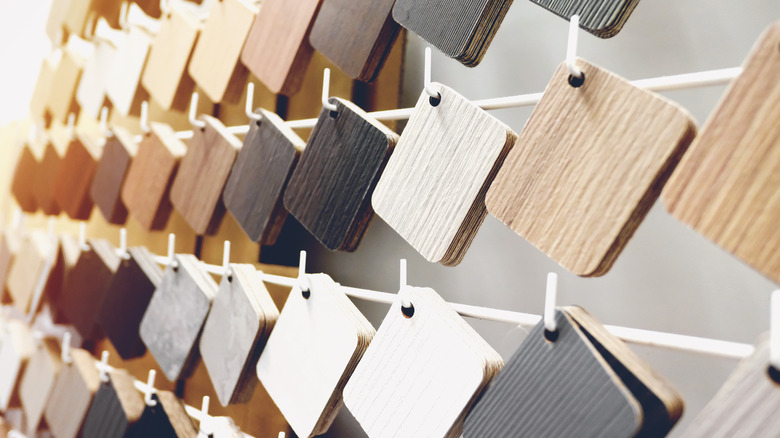The Real Reason Laminate Flooring Is Better Than Hardwood
Owning a home is hard. Every little decision seems like a big one, and that's because it usually is. Whether it's to ditch the landscaping in the front yard and go low-maintenance or finally knock down that wall to create an open floorplan, you're likely in for a bit of Googling before your next big project.
When you own a home, there's a whole lot of research to do about each and every new purchase, paint job, or renovation. Some old-school homeowners might tell you to stick with what's always worked, like hardwood floors, at least one bathtub (even if you don't have kids and would prefer a rainfall shower), and a simple kitchen that won't scare future buyers away.
At the end of the day, though, your house is just that: Yours. You don't pay a mortgage to live in your home like a temporary renter — you own a home to spruce it up and maintain it in a way that suits your personality and lifestyle.
That's why we're here to dispel one big homeowning myth once and for all: That traditional hardwood flooring is the superior choice. Can today's trendy laminate floors really live up to — and even exceed — hardwood? We say yes. Keep reading to find out the real reason laminate flooring is better than hardwood.
What's the difference between hardwood and laminate flooring?
Hardwood flooring typically has a better reputation than laminate, but a lot of that has to do with how long it's been around. Walk into any old home, even those built back in the late 1800s, and you may find some well-loved hardwood underneath years of vinyl tile. These hardwood floors are usually just under an inch thick, solid wood throughout, usually stained a certain color, and finished to seal and protect them, explains Flooring Stores.
Nowadays, most homeowners pick between two options for wood-look flooring: engineered hardwood or laminate. Engineered hardwood is slightly thinner than hardwood and has a bottom layer of cheaper plywood, which is then topped with a wood veneer. Laminate flooring is similar in that it's made up of several layers, and it's thinner than your traditional hardwood. The bottom is usually fiberboard, which offers support and a little bit of extra give. Instead of a wood veneer, the next portion is a "photo" layer, which is a graphic overlay of your desired flooring look. The photo layer is then coated by a "wear" layer, which is intended to protect against the typical wear and tear.
Save big time with laminate over hardwood
One of the biggest reasons more and more homeowners are trending towards laminate over traditional hardwood is the sheer difference in cost. Generally, laminate flooring is a more affordable option. The total cost depends on the quality of laminate you spring for, but, at the end of the day, even a higher-end laminate will be easier on your wallet than the average hardwood.
According to The Spruce, the average cost of solid hardwood flooring — without installation — is about $8 per square foot. That price could be cut in half if you opt for a more common wood, but if you're shooting for the trendy, wide-plank, washed-wood floor of your dreams, be prepared to pay.
On the other hand, The Spruce estimates that laminate flooring costs between $1 and $3 per square foot. That price can quickly skyrocket to over $10 per square foot, depending on the quality and finish you're looking for, but for a comparable solid hardwood style, you'll still be saving big time. Carpet Captain explains that "high-quality laminate floors cost about as much as less-expensive hardwood." So, if quality is important to you, then splurge on some nicer laminate over a cheaper wood. But cost isn't the only advantage laminate has over hardwood.
Laminate flooring is a DIY dream
Because of the way laminate flooring is made, it boasts one major selling point over hardwood: Many agree that it's a DIY project that you can, well, actually do by yourself. Installing laminate floors is relatively simple.
One of the main perks of laminate flooring is that it's a "floating" option, unlike hardwood. That means it can be installed over any existing floor, per HomeAdvisor. Cold concrete in your half-finished basement? Place laminate on top. Dated, yellowed vinyl tile in your otherwise updated kitchen? You guessed it: Go for laminate. You can even install it over existing hardwood floors that you just don't have the time or energy to refinish — no judgment here!
Typically, laminate floors come completely finished, and they are installed following a simple tongue and groove system. That means no sanding and minimal effort. Just cut each piece to size, and slide each plank to lock it in place on the floor.
Hardwood, however, is a major headache to install. HomeAdvisor suggests hiring a professional to install solid wood floors since they come unfinished and don't follow the same interlocking system. That means you're paying a premium for installation and materials. If you opt for installing your own laminate, the total project cost could be cut in half.
You can achieve any look you want for less
A common misconception about laminate is that, while it's a cheaper option, it looks like a cheaper option. And that's a somewhat fair assessment: Since laminate is made up of synthetic materials with a graphic image overlay, low-quality versions can look printed and fake. Yet, while no alternative will look and feel just like real wood, laminate has quickly grown into a more respectable — and realistic — flooring option for even the more sophisticated design schemes.
According to Flooring Inc., laminate has come a long way over the years. Newer versions of the floor are embossed in register, which effortlessly blends the photo layer with a realistic texture that mimics hardwood. Think of it this way: Back in the '70s, laminate flooring was the Microsoft Paint of floors. All types of laminate looked like cut-copy-paste art projects, with repetitive and unrealistic-looking wood-grain graphics. But, now, laminate is the PhotoShop of floors. While it's certainly not real, you'd be hard-pressed to tell.
One of the other pros of laminate flooring over hardwood is that you can try out any style or trend with your floors without paying a steep price. If you like the look of bamboo but can't even imagine the cost of an exotic hardwood, laminate is your best bet. Since the wood grain is printed on, you can venture out and consider more luxurious and expensive-looking choices.
Laminate floors are surprisingly durable
There's no doubt that original hardwood floors have a character and charm that laminate floors might not. But let's admit it: Half of that charm is just decades' worth of scratches from footsteps and kids' toys.
Thanks to its protective "wear" layer, laminate allows homeowners to keep their floor looking brand new with very little maintenance. According to Floor Critics, this added layer contains aluminum oxide, which is not found in hardwood flooring. It makes laminate heavy-duty and ready for whatever life might throw at you (or drop on your floor). Hardwood floors get scratched and stay scratched until you sand them down and refinish them, but laminate masks most everyday mishaps.
This topcoat also prevents any additional weathering from the sun, which is common in hardwood. In older homes, you might find a square or two of discoloration where a rug used to be. That's because the UV rays from the sun changed the color of the exposed floor over time. While hardwood may last a lifetime, it won't look good for a lifetime without a lot of maintenance. With laminate, you don't have to worry about that kind of maintenance.
And, when it comes to owning a home, there's already enough to worry about. So, why not ditch tradition, save a pretty penny, and make the move to laminate?





